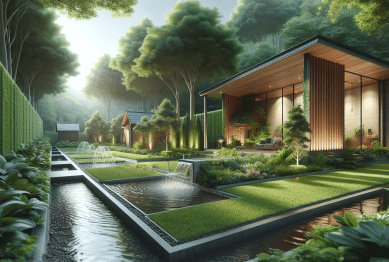Smart home gardening blends technology and nature, opening new ways to grow food and flowers indoors or out. This guide explores key benefits, practical tools, and surprising options for creating a garden that fits your lifestyle.
Understanding Smart Home Gardening and Its Benefits
Smart home gardening is changing the way people grow plants, combining sensors, automation, and mobile technology. Many are surprised by how easy it becomes to achieve lush growth indoors or outdoors using connected devices. With automated watering systems and app-controlled lights, the management of plant health is streamlined, helping both beginners and enthusiasts grow more with less guesswork. The benefits extend further: smart gardening often leads to healthier plants, reduced waste of water, and improved energy efficiency, making it a sustainable approach for modern households. Gardening in this way helps balance home aesthetics and environmental care, integrating nature with daily tech routines.
Smart plant monitors and irrigation systems are widely available, allowing gardeners to track soil conditions, moisture, and sunlight in real time. This instant feedback means plants get what they need precisely when needed. For families and those juggling busy routines, it removes much of the uncertainty from gardening. Just imagine waking up to a garden that largely takes care of itself, with reminders or actions managed over Wi-Fi. These improvements empower anyone to grow food, herbs, or flowers—regardless of experience or physical ability—making smart gardening an accessible hobby.
One underappreciated advantage is the increase in overall well-being from smart home gardening. Studies indicate that regular plant care contributes to reduced stress and sharpened focus, thanks to the fusion of interactive tech and nature (see https://www.ncbi.nlm.nih.gov/pmc/articles/PMC4419447/). Smart systems also enable gardeners to cultivate a broader variety of plants, regardless of seasonal changes or climate, broadening horticultural possibilities in small apartments or urban homes. With less manual labor, gardening becomes inclusive, enjoyable, and more productive all year round.
Choosing the Right Smart Planters and Tools
Picking the right smart gardening equipment is the foundation for a thriving green space. Many planters now come with built-in moisture sensors, adjustable lighting, and even voice control compatibility, giving gardeners more flexibility than traditional pots. Factors such as available space, sunlight, and desired crop types influence the most suitable devices. Smart irrigation kits, for example, take the guesswork out of scheduling, while indoor hydroponic systems let herbs flourish on kitchen counters. These innovative planters blend with home decor, ensuring that technology enhances rather than disrupts living spaces. The variety of options means there’s a solution for almost any budget or design preference, so explore what fits your needs and lifestyle.
Some of the most popular tools include Wi-Fi-connected soil sensors, programmable irrigation valves, and AI-powered grow lights. These gadgets adjust to plant needs throughout the growth cycle. Soil sensors track moisture, pH, and nutrient balance, alerting you via smartphone apps before problems arise. Programmable valves and timers adapt to local weather conditions, minimizing water usage and maximizing efficiency for garden beds or potted plants outside (see https://www.energy.gov/eere/articles/3-tips-save-water-home-garden). The integration of these devices reduces manual watering, cutting down on routine tasks and promoting sustainable water management.
Lighting is another crucial element. Smart grow lights mimic the sun’s natural rhythm, supporting plants through each life stage, even in dimly lit homes. Many can be set to specific wavelengths or brightness levels for different species—making it possible to grow fruiting vegetables, microgreens, and tropical flowers regardless of window placement. By choosing compatible tools, gardeners can create a seamless ecosystem that works both indoors and outdoors. A smart garden toolkit gives the confidence needed to experiment with different crops and layouts, knowing that help is a notification away.
Getting Started: Simple Smart Gardening Upgrades
For beginners, small upgrades can make a big difference in smart home gardening. Start with a basic moisture sensor and automatic watering system; these two items alone greatly reduce the risk of overwatering or forgetting scheduled care. Many sensors gently remind users when plants need attention. This technology doesn’t just protect your investment—it supports plant health and encourages steady growth, aligning with the broader shift toward eco-conscious gardening. By tracking and adjusting daily routines using real data, anyone can avoid common pitfalls like root rot or dryness, making gardening more successful and enjoyable.
Another accessible upgrade is installing LED grow lights. These are especially useful for apartments or homes with limited sunlight. With energy-efficient settings, modern lights simulate the full spectrum plants need, plugging directly into outlets or smart home hubs. Pairing these lights with a timer or app automation ensures plants receive optimal care, even while users are on vacation or at work. Over time, simple automation solutions add up, freeing up time for enjoying the garden, not just maintaining it. These initial upgrades build the foundation for more complex systems later, setting the stage for future expansion.
Consider integrating a basic home automation assistant into the gardening setup. Many people use platforms like Google Home or Alexa to manage watering schedules, monitor humidity, or activate lighting through simple voice commands. By starting with easy-to-install devices and gradually expanding, it becomes easy to tailor a smart gardening system to any lifestyle. Step by step, small improvements support a healthier home environment and demonstrate how innovation can work in harmony with nature.
Indoor Versus Outdoor Smart Gardening Solutions
Choosing between indoor and outdoor smart gardening approaches depends on available space, climate, and plant selection. Indoor setups usually focus on compact planters, hydroponic kits, and grow lights, offering year-round conditions for herbs, microgreens, and decorative plants. The consistency of indoor controls provides an ideal environment for urban dwellers or those seeking fresh produce regardless of outdoor weather. Indoor systems also use less water and require less soil, making them a resource-friendly choice. These setups are often flexible, growing with the needs of the gardener, while focusing on convenience and reliability.
Outdoor smart gardening leverages natural sunlight but enhances care with weather-aware irrigation controllers, solar-powered sensors, and robust automation. These solutions are designed to withstand varying temperatures and rainfall, automatically adjusting routines to conserve water and optimize plant health (see https://www.epa.gov/watersense/outdoor). Gardeners find that outdoor systems help maintain lawns, flower beds, and vegetable plots without the need for constant manual adjustment. Many outdoor smart products now use solar energy, lowering operating costs and supporting sustainable living. Nature and technology blend seamlessly, allowing lush landscapes with improved efficiency and less effort.
There are also hybrid options, such as portable self-watering containers or modular raised beds wired with smart sensors, letting users move plants between spaces as needed. These flexible systems allow for creative experimentation—growing strawberries indoors during cold months, then transitioning to an outdoor trellis as temperatures rise. By blending indoor and outdoor solutions, gardeners get year-round productivity, improved resilience against pests and weather changes, and the joy of cultivating a wider range of crops. Personalizing the gardening experience becomes simple and rewarding, supported by the right mix of innovation and tradition.
Sustainability and Water Conservation in Smart Home Gardens
One of the central goals of smart gardening is sustainability, particularly regarding water conservation. Modern irrigation controllers gather weather data and soil moisture readings to deliver precise watering, avoiding the waste common in traditional gardens. These systems can reduce water usage by up to 50% when compared to manual watering (see https://www.epa.gov/watersense/landscaping-tips). The technology benefits not only homeowners’ utility costs but the environment by promoting responsible stewardship of resources. Growing awareness of water scarcity makes these innovations crucial for both large and small gardens.
Collecting rainwater and using it with smart irrigation setups adds another layer of efficiency. Smart systems track water tank levels, toggling between rainwater and municipal supply based on availability and demand. Reusing water in this way supports self-sufficient gardens, lowering the burden on public water infrastructure. When combined with drought-resistant plants and mulch, smart garden strategies further extend natural resilience, requiring less intervention and producing dependable yields throughout the year. The result? A healthier, lower-cost, and more eco-friendly home garden accessible to all.
Smart gardens also support organic and sustainable agriculture principles through precision fertilization and pest monitoring. Devices can alert gardeners when nutrients are lacking, reducing reliance on synthetic additives and supporting soil health. Natural pest controls like pheromone traps and biological indicators now connect to garden apps, enabling timely, non-toxic interventions (see https://www.ars.usda.gov/news-events/news/research-news/2021/smart-irrigation-and-fertilization-could-boost-crop-productivity/). This thoughtful integration of smart technology fosters healthier gardens and landscapes, modeling sustainable practices for future generations.
Expanding Your Smart Garden for Food, Wellness, and Fun
Many gardeners begin with simple herbs and flowers, gradually expanding into vegetables, fruits, and even aquaponics with the confidence that smart systems provide. Homegrown leafy greens, tomatoes, or strawberries become staples of the kitchen, delivering unbeatable freshness and nutrition. Beyond produce, cultivating medicinal plants like mint or lavender offers natural wellness benefits, while supporting pollinators and local biodiversity. Smart gardening facilitates experimentation, allowing for new plant varieties each season. As comfort with the technology grows, so does ambition and the satisfaction of homegrown success.
Wellness extends far beyond food. According to research, tending a garden enhances mood, lowers anxiety, and boosts daily energy. The beauty of smart home gardening is that it reduces tedious tasks, letting users enjoy creative aspects like designing plant arrangements or experimenting with vertical gardens. For many, it becomes a shared family activity or source of learning for children, blending science with hands-on practice and community connection. Gardeners discover that growing food and flowers isn’t just practical or edible—it’s an investment in quality of life (see https://journals.sagepub.com/doi/pdf/10.1177/1359105314526941).
There’s also room for fun! Smart gardens now feature automated seed starters, mood-based lighting, and even music integration. These creative tools keep the process fresh and enjoyable, inspiring continued learning and new projects year after year. By inviting innovation, smart home gardens foster curiosity, resilience, and satisfaction for everyone. More than a trend, it’s a lifestyle shift—one where technology and tradition thrive together.
References
1. Park, S.H., & Mattson, R.H. (2015). Effects of Flowering and Foliage Plants in Hospital Rooms on Patients Recovering from Abdominal Surgery. Retrieved from https://www.ncbi.nlm.nih.gov/pmc/articles/PMC4419447/
2. U.S. Department of Energy. (n.d.). 3 Tips to Save Water in the Home Garden. Retrieved from https://www.energy.gov/eere/articles/3-tips-save-water-home-garden
3. U.S. Environmental Protection Agency. (n.d.). Outdoor Water Use. Retrieved from https://www.epa.gov/watersense/outdoor
4. U.S. Environmental Protection Agency. (n.d.). Landscaping Tips. Retrieved from https://www.epa.gov/watersense/landscaping-tips
5. USDA Agricultural Research Service. (2021). Smart Irrigation and Fertilization Could Boost Crop Productivity. Retrieved from https://www.ars.usda.gov/news-events/news/research-news/2021/smart-irrigation-and-fertilization-could-boost-crop-productivity/
6. Van Den Berg, A.E., & Custers, M.H.G. (2011). Gardening Promotes Neuroendocrine and Affective Restoration from Stress. Retrieved from https://journals.sagepub.com/doi/pdf/10.1177/1359105314526941









